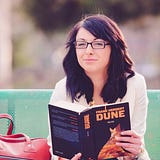What Happens When Men Write Women
A look at women in literature through a feminist lens

A look at women in literature through a feminist lens
Women in fiction written by men seem to be the epitome of a dilemma between the women that male authors are trying to imagine and those they deem appropriate to portray. This rift often leads to hilarious descriptions and some situations that would make any female reader cringe.
This article is an attempt to understand the significant mistakes male writers make while describing women, and how the power of a feminine voice can change the cliches that exist in English literature.
Too Many Stereotypes
In all the 750+ books I have read, I came across several stereotypes that are common when male authors write female characters. Here are some of the most common cliches about women in literature:
Fixation on physical beauty
Women in fiction are often described as good-looking, their impossible beauty being one of the fundamental tenets that make up their existence. Sometimes, it is painfully embarrassing to see how much some male writers are obsessed with the physical attributes of a woman’s body.
Here is an excerpt from Warbreaker by Brandon Sanderson-
Mercystar was a gorgeously voluptuous woman who offered a string contrast with Blushweaver. Both were, of course, perfect examples of feminine beauty. Blushweaver was simply the slim — yet busty — type while Mercystar was the curvaceous — yet busty — type.
Of course, would it be possible to be “perfect examples of feminine beauty” without being “the busty type”?
In another example, here are the thoughts that go through the head of Ambrosio, the male lead in The Monk by Matthew Lewis-
The Friar’s eyes followed with dread the course of the dagger. She had torn open her habit, and her bosom was half exposed. The weapon’s point rested upon her left breast: and oh! that was such a breast! The moonbeams darting full upon it enabled the Monk to observe its dazzling whiteness. His eye dwelt with insatiable avidity upon the beauteous orb: a sensation till then unknown filled his heart with a mixture of anxiety and delight: a raging fire shot through every limb; the blood boiled in his veins, and a thousand wishes bewildered his imagination.
Okay, calm down, Ambrosio! It’s just a breast, not a beauteous orb!
Obsession with romance
Women in fiction written by male writers are obsessed with romance.
Often, to the extent, they’re prepared to give up everything they’d worked for, only for the sake of writing their love story.
These descriptions make most female readers cringe.
There are many strong female characters in The Kingkiller Chronicles by Patrick Rothfuss. However, when it comes to helping the central male character, Kvothe, these beautiful, powerful, ambitious women (Fela, Devi, Felurian, Auri, and many more) are prepared to make significant personal sacrifices, often at the cost of their profession or ambition.
Rothfuss’s women are depicted as willing to sacrifice their life’s goals for the man — as if their lives and identities are defined by their male counterparts.
A prime example of this is the American poet, Charles Bukowski. My reader friends all know that I tried reading The Post Office several times. but could never proceed beyond the first few pages because of how badly women were depicted in that universe.
Here’s an excerpt from Bukowski’s Women:
While men were watching professional football or drinking beer or bowling, they, the women, were thinking about us, concentrating, studying, deciding–whether to accept us, discard us, exchange us, kill us or whether simply to leave us.
Poetic, much?
Romance novels written by men often have the stereotype of a man who isn’t very good-looking falling for a woman way out of his league (looks-wise). The male protagonists often wax eloquent about their female love interests, resorting to poetry and purple prose. Here is an excerpt from Looking for Alaska by John Green:
I was gawky and she was gorgeous and I was hopelessly boring and she was endlessly fascinating. So I walked back to my room and collapsed on the bottom bunk, thinking that if people were rain, I was drizzle and she was hurricane.
A Measure of Feminine Representation in Fiction
The Bechdel test, named after the American cartoonist Alison Bechdel is a measure of the representation of women in fiction. Also known as the Bechdel–Wallace test, this test has two criteria that a work of fiction must follow in order to satisfy it, namely-
- The book has to have at least two women in it, who talk to each other about something other than a man.
- These two female characters must have names.
According to Neda Ulaby, the Bechdel test resonates because:
It articulates something often missing in popular culture: not the number of women we see on screen, but the depth of their stories, and the range of their concerns.
Some wildly popular books that fail the Bechdel test are -
- The Hitchhiker’s Guide to the Galaxy
- The Great Gatsby
- Fifty Shades of Grey
The Power of a Feminine Voice
When you read fiction written by women authors, you would get a representation of “real” women, rather than characters based on the fantasies or perspectives of men. You would get an image of the flaws, quirks, and traits that make up a woman, other than merely her physical beauty.
Here is an example of how Arundhati Roy describes her female lead, Tilo, in The Ministry of Utmost Happiness-
Her long, thick hair was neither straight nor curly, but tangled and uncared for. I could imagine small birds nesting in it. It would have easily made the Before part of a Before-After shampoo commercial.
As you can see — Roy writes it as you would expect a real woman to be like. There is no meaningless poetry, no fixation on her flawless exterior, no glorification just because she happens to be a woman. In fact, there is nothing but the plain truth.
Apart from Arundhati Roy, so many other female authors have carved out a niche for themselves in the world of English literature. If you are looking for recommendations, here are the top five books I would recommend-
- The Poet X by Elizabeth Acevado
- The Inheritance of Loss by Kiran Desai
- It’s Not About the Burqa by Mariam Khan
- The Handmaid’s Tale by Margaret Atwood
- The Bell Jar by Sylvia Plath
Apart from these, I have also made a list of books by Indian women authors and contemporary women-centric fiction. You can browse through and maybe pick your next book from-


If you enjoyed my take on men writing women, you might like these articles too-


For book reviews and recommendations, follow me on Goodreads.
